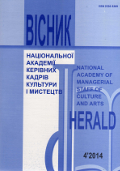ВИЗНАЧЕННЯ МЕЖІ ІНТЕРПРЕТАТИВНОЇ СВОБОДИ ПЕРЕКЛАДАЧА ЛІРИЧНОЇ ПОЕЗІЇ (КУЛЬТУРОЛОГІЧНИЙ АСПЕКТ)
Finding Borders of interpretation Freedom of Lyric Poetry Translator (Culturological Aspect)
Author(s): Volodymyr TsybulkoSubject(s): Studies of Literature, Translation Studies, Theory of Literature
Published by: Національна академія керівних кадрів культури і мистецтв
Keywords: Interpretive freedom; universally existential code; immanent translation; trans-translation translation; free translation; conditional formula of unchanging the original;
Summary/Abstract: The article deals with the matter of finding borders of interpretation freedom in case of lyric poetry translation. This matter is viewed upon from the point of view of the culturologic science and the theory of dialog, being a part of this science. A border between the notions of transformational and free translation has been defined.The author focuses on the specific features of transformational model of poetic translation in comparison with free translation in order to define differences between these approaches. The author considers it to be an important matter. The culturologic point of view on transformational method of translation presents the translator with a wide range of interpretation freedom in comparison with the traditional immanent method.To reach the goals of this article the author makes the emphasis on the philosophy of dialog where mechanisms of preserving author’s self has been developed in the context of intertext relations and the author’s interrelation with the other.The author of the article defines two poles (scientific texts and literary text) of the role of culture in the process of translation and translator’s borders of freedom. In scientific translation the role of culture is the weakest but in case with poetic works translation this role is the strongest.To describe the strongest influence of culture in case with poetic translation the author of this article notices the strongest refiguration of the source language in comparison with the language target. According to this point of view translator’s freedom of any translation is limited only with the category of "Original permanence formula".In case with the transformational method of poetic translation "Original permanence formula" is defined through power of influence of images and not the language itself which gives an opportunity to make the result more comfortable. Although this is a characteristic of free translation. The author of this article notices that the notions of transformational translation and free translations are not synonymic. The main characteristic ("Original permanence formula") that creates difference between transformational translation and free translation is the form (the meter, number of lines, system of rhyming) which can be completely changed in case with free translation but must be preserved in case with transformational translation as a form is a priory of intercultural nature. Despite of this the author notes that the transformational translation form may also be changed to certain extent depending on concrete situation.The author makes the conclusions that the "Original permanence formula" cannot be defined. He also defines the formal elements that are not the parts of this formula (number of steps and partially system of rhyming).This article is a part of the author's dissertation research ("Poetic Translation as a Phenomenon of Cultural Senses Interpretation") and contains a number of questions which he is going to answer during his further scientific works.
Journal: Вісник Національної академії керівних кадрів культури і мистецтв
- Issue Year: 2014
- Issue No: 4
- Page Range: 69-73
- Page Count: 5
- Language: Ukrainian

